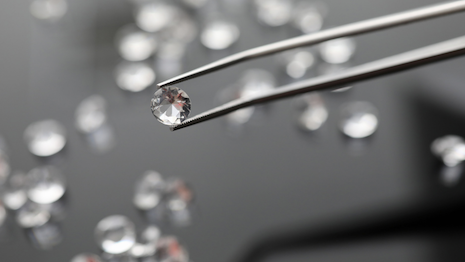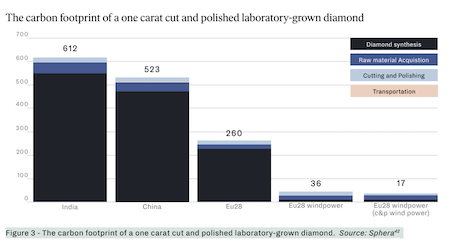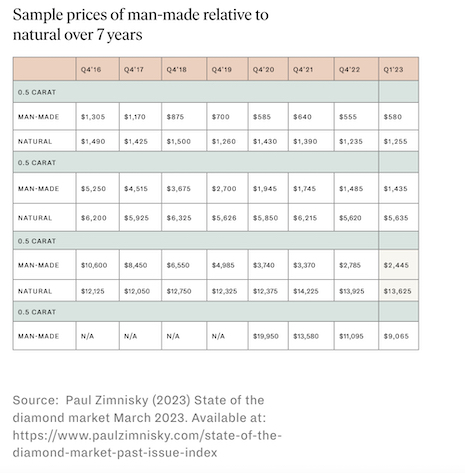 The Council is attempting to set the record straight on misconceptions concerning natural diamonds versus laboratory-grown varieties via a new report. Image courtesy of Natural Diamonds Council
The Council is attempting to set the record straight on misconceptions concerning natural diamonds versus laboratory-grown varieties via a new report. Image courtesy of Natural Diamonds Council
The Natural Diamond Council (NDC) is attempting to set the record straight on a few common misgivings concerning natural gemstones.
In a time of advent for the use of alternate accessorial materials, the average price of a 1.5-carat laboratory-grown diamond has decreased by over 74 percent from 2016 to 2023, according to Council experts. The organization's latest report, “Diamond Facts: Addressing myths and misconceptions about the diamond industry,” aims to clarify, assigning differentiators between lab-grown diamonds and those sourced naturally.
“In an age where consumers are more inquisitive and enlightened than ever, they wish to know about the values and responsible business practices from the companies and indeed the wider industry from which they are purchasing,” says David Kellie, CEO of the NDC, in a statement.
“At the Natural Diamond Council, we want to support consumers in taking informed decisions by providing information transparently.”
NDC shares that report findings are derived from a thorough review of a wide range of secondary research sources and the evaluation of internal research conducted on behalf of the Natural Diamond Council by globally respected third-party organizations. The research was conducted at the beginning of 2023.
Nature versus nurture
NDC’s report findings suggest that lab-grown diamonds have experienced significant price depreciation in recent years. Meanwhile, natural diamond prices have risen at an average of 3 percent over the last 35 years.
As part of the effort, the organization aims to clear up a few more fallacies regarding the production of lab-grown varieties, listing that not all of these items are made sustainably.
Requiring temperatures similar to 20 percent of that of the Sun’s surface, the research exercise finds that the weekslong manufacturing process for lab-grown diamonds is fairly energy-intensive.
Furthermore, 3 of every five lab-grown diamonds are mass-produced in jurisdictions including China and India, and while some players in the alternative materials space make claim to mining-free processes in marketing, authors of the report have called this premise into question.
According to the organization, synthetic diamond production can require graphite and metals. Moreover, the reactors in which laboratory-grown diamonds are created are constructed with metals originating from mining, per the Council.
Interestingly, a side-by-side study conducted by analyst Paul Zimnisky discovered that, in 2016, a one-carat round, almost colorless, high-quality synthetic stone cost around 10 percent less than a natural diamond.
By the end of 2022 though, depending on the manufacturer, the differential could hit as high as 80 percent between a natural gem and a lab-grown one.
Over the years, automation across the lab-grown space has pushed a typical, generic, one-carat laboratory-grown stone of this color and clarity to retail at more than 70 percent cheaper than a natural diamond at the end of 2022, the experts say.
“The diamond industry continues to go from strength to strength,” Mr. Kellie said, in a statement.
“Yet, myths surrounding the industry’s operations, its standards and its players continue to perpetuate,” he said. “This is, in part, a result of a historical legacy that has not yet been fully corrected, despite the transformation and reform which has occurred over recent decades.”
Carat considerations
While some larger luxury entities have taken on the fight against other issues threatening the jewelry and watchmaking industries – product theft included (see story) – NDC’s report tackles the issue of mislabeling by providing legal definitions and advertising guidelines, available to all consumers seeking specific diamond options (see story).
Contents point to the use of the word “diamond” on its own as indicative of a natural diamond reference.
The Council’s experts additionally share that an overwhelming majority of global standards only allow for the use of three terms to describe synthetic diamonds. These include “synthetic diamonds,” “laboratory-grown diamonds,” and “laboratory-created diamonds.”
View this post on Instagram
Stateside, terms that include the manufacturer’s name, followed by the word “created” are permitted.
“The modern diamond industry is not perfect, and of course has challenges and areas of improvement,” Mr. Kellie said.
“Our strength is the unity with which we address opportunities and challenges,” he said. “The diamond industry supports the livelihoods of 10 million people across the world, helping to provide better access to healthcare, education, infrastructure, as well as scale and access to funding to contribute to solving some of the world’s biggest challenges.”
“The industry is also pursuing land protection and rehabilitation across continents with fervor.”

